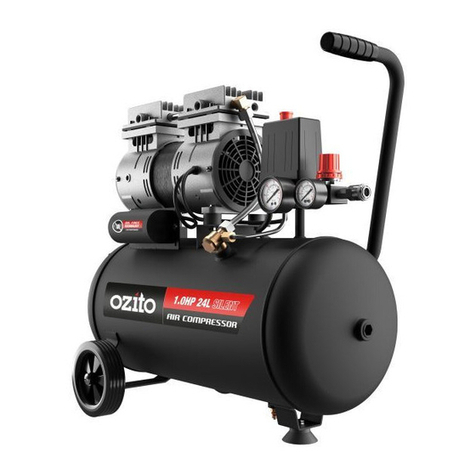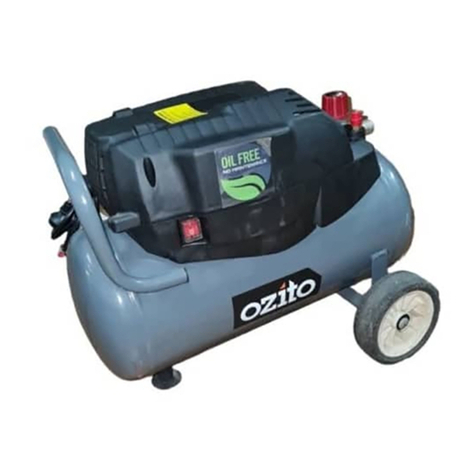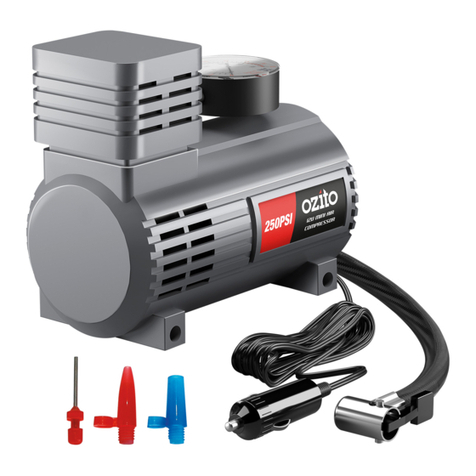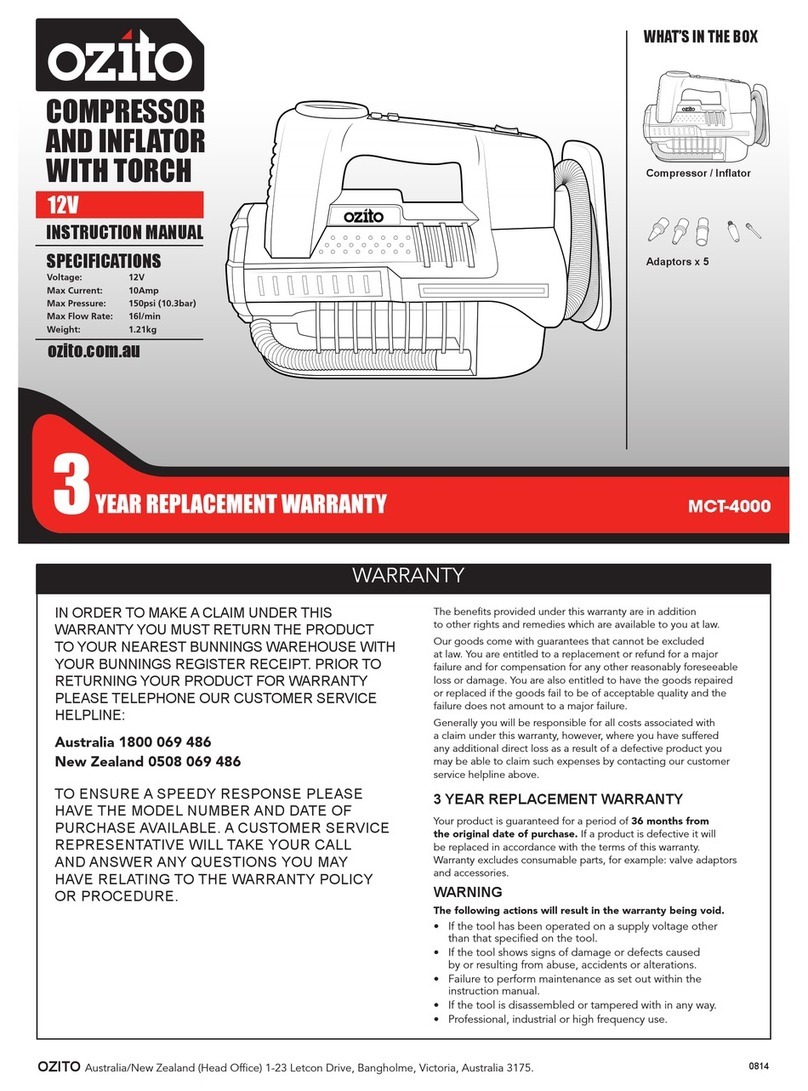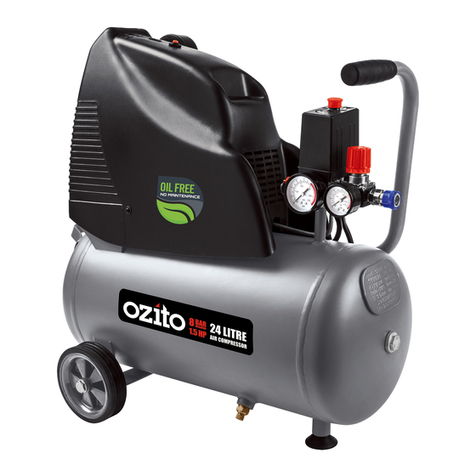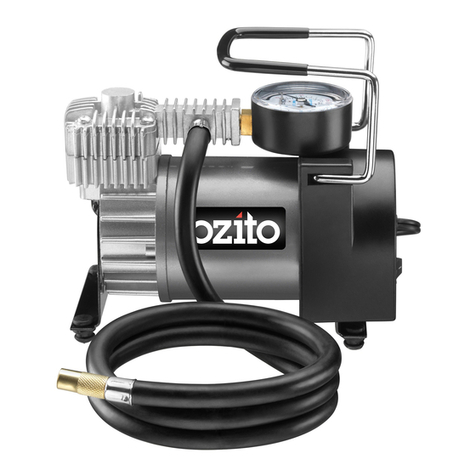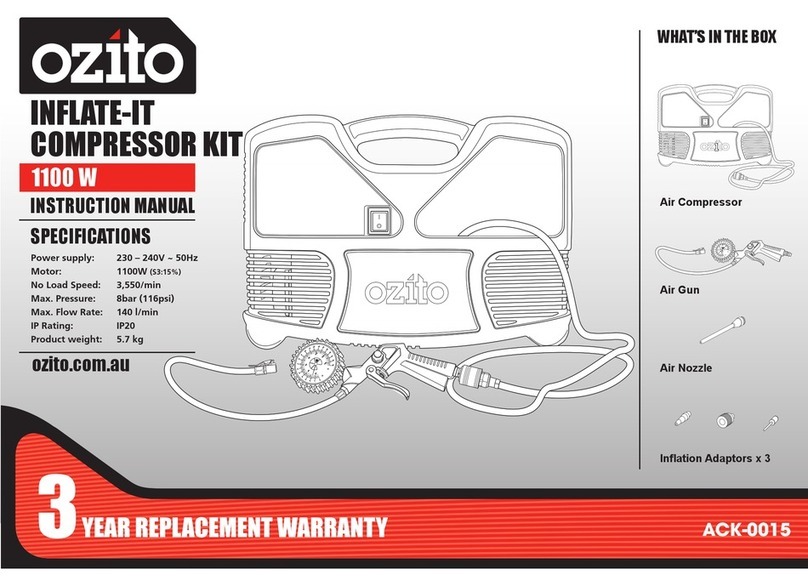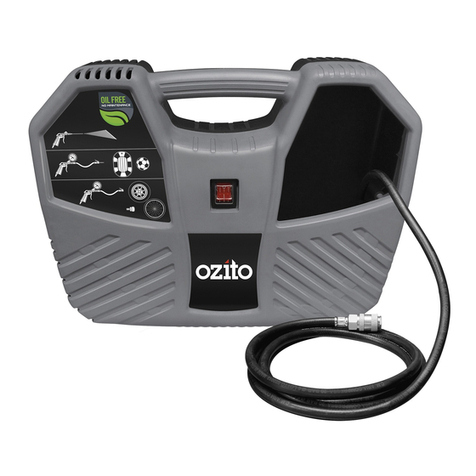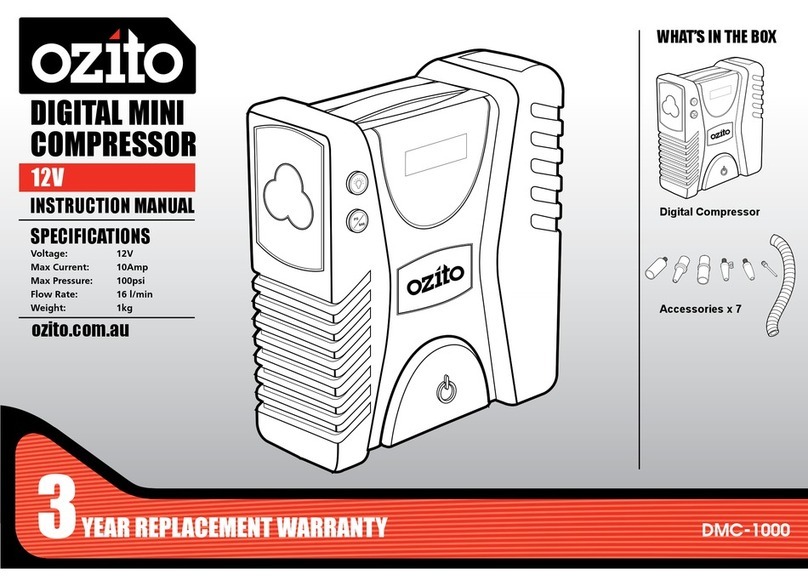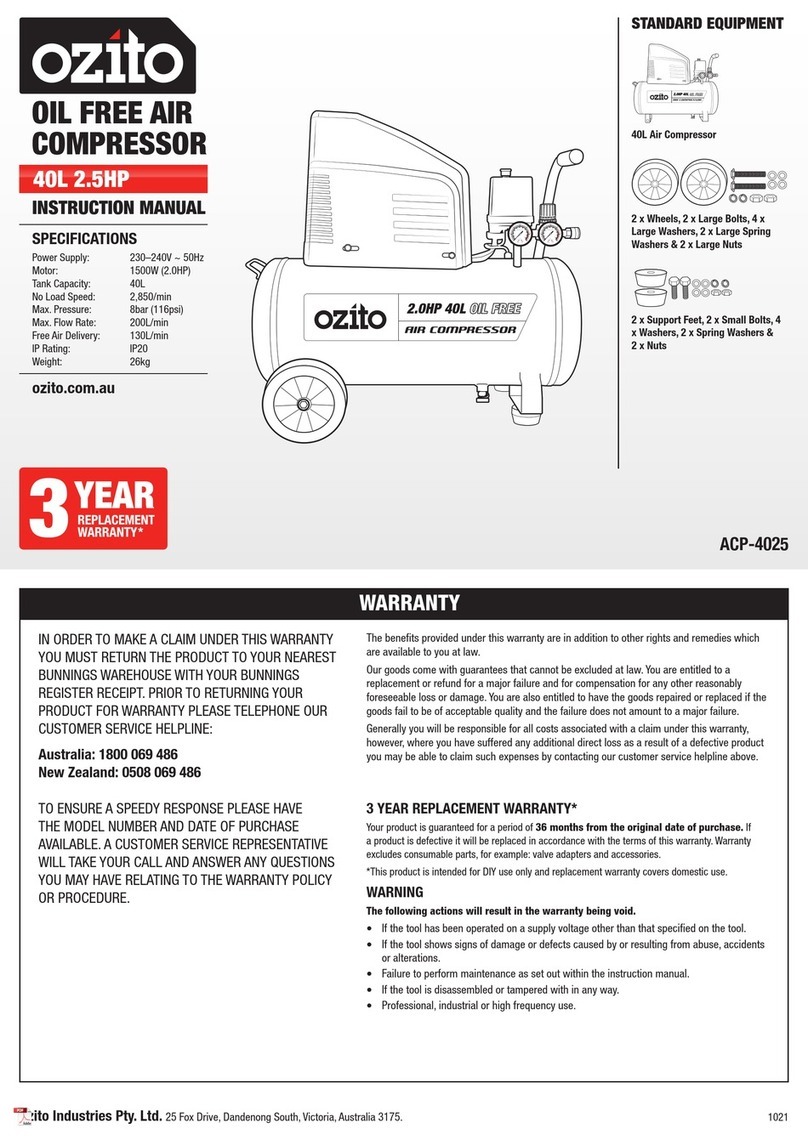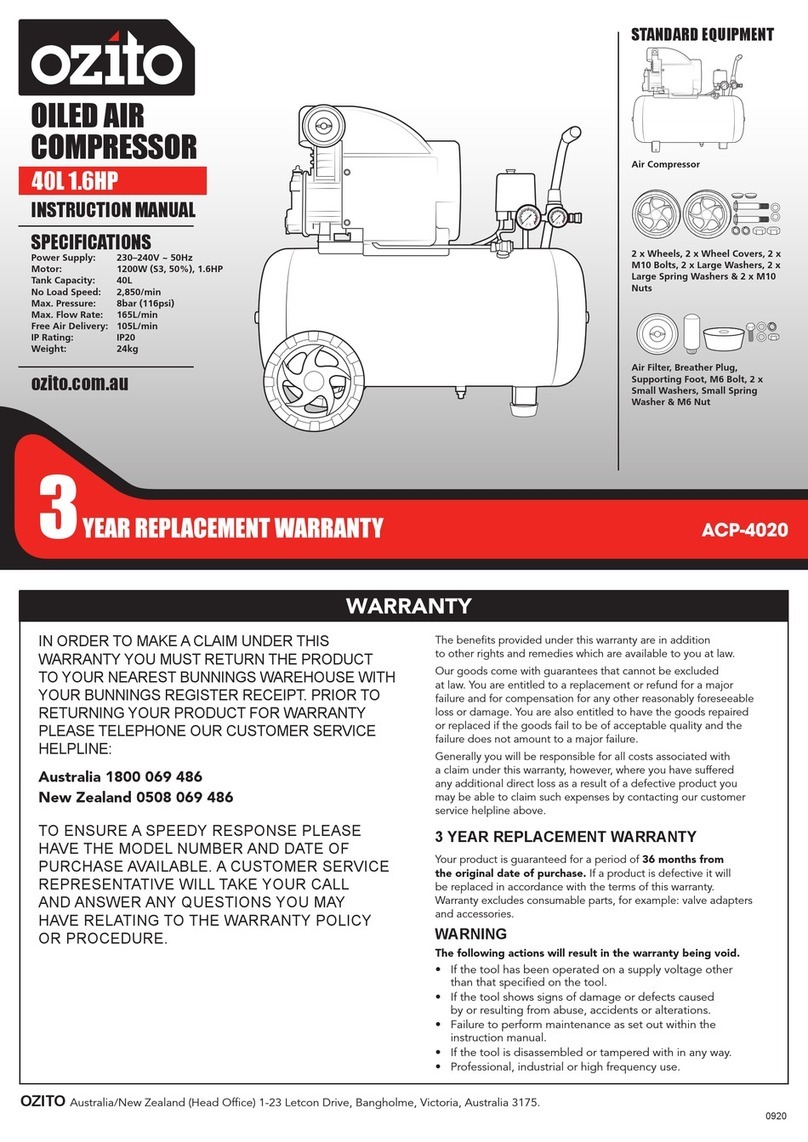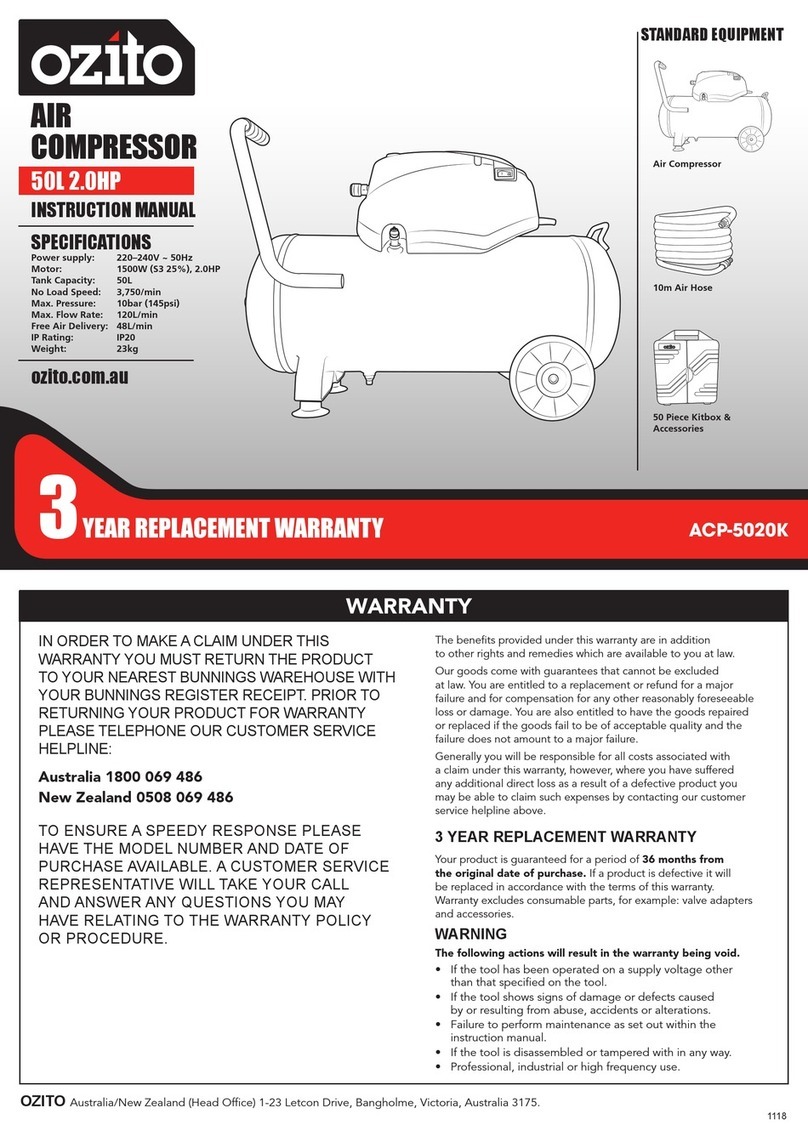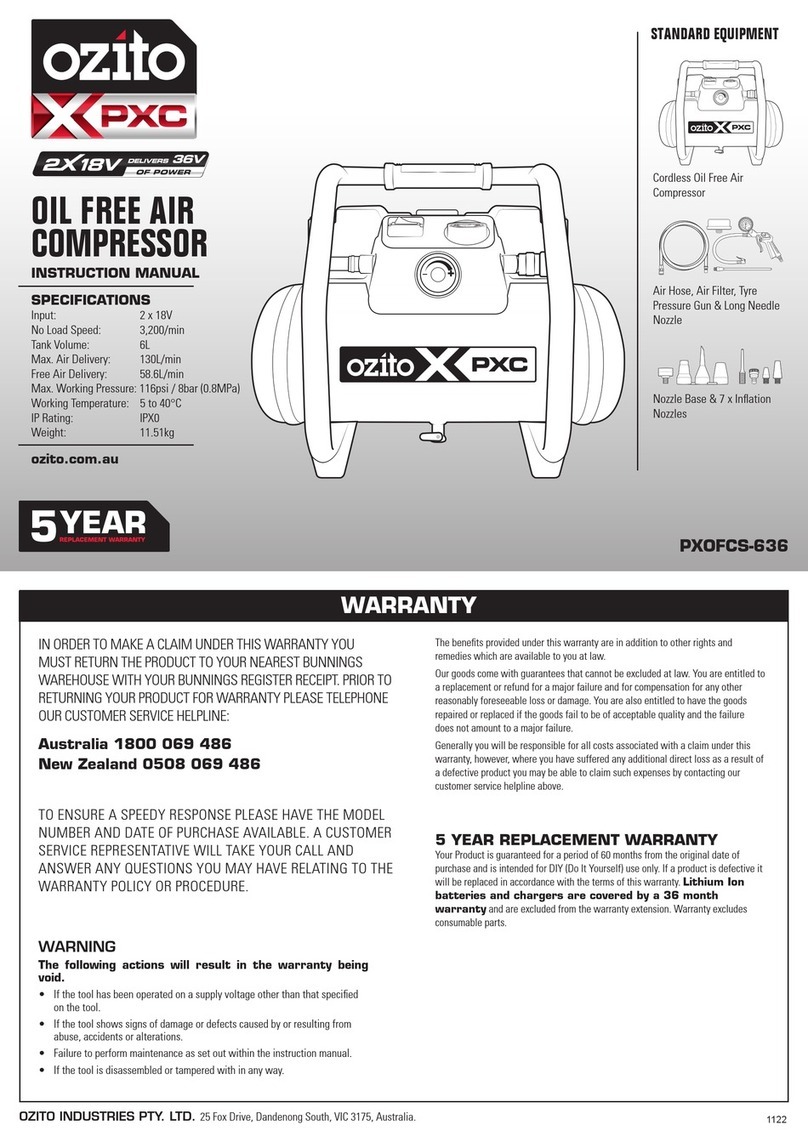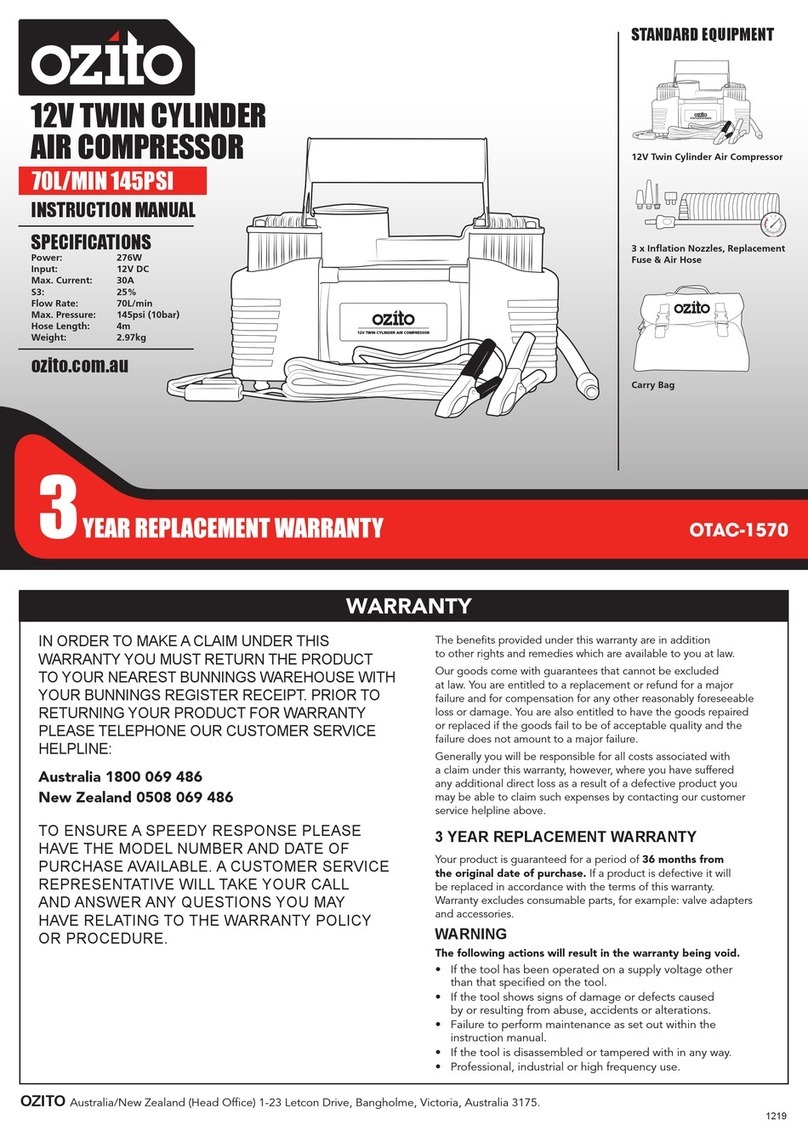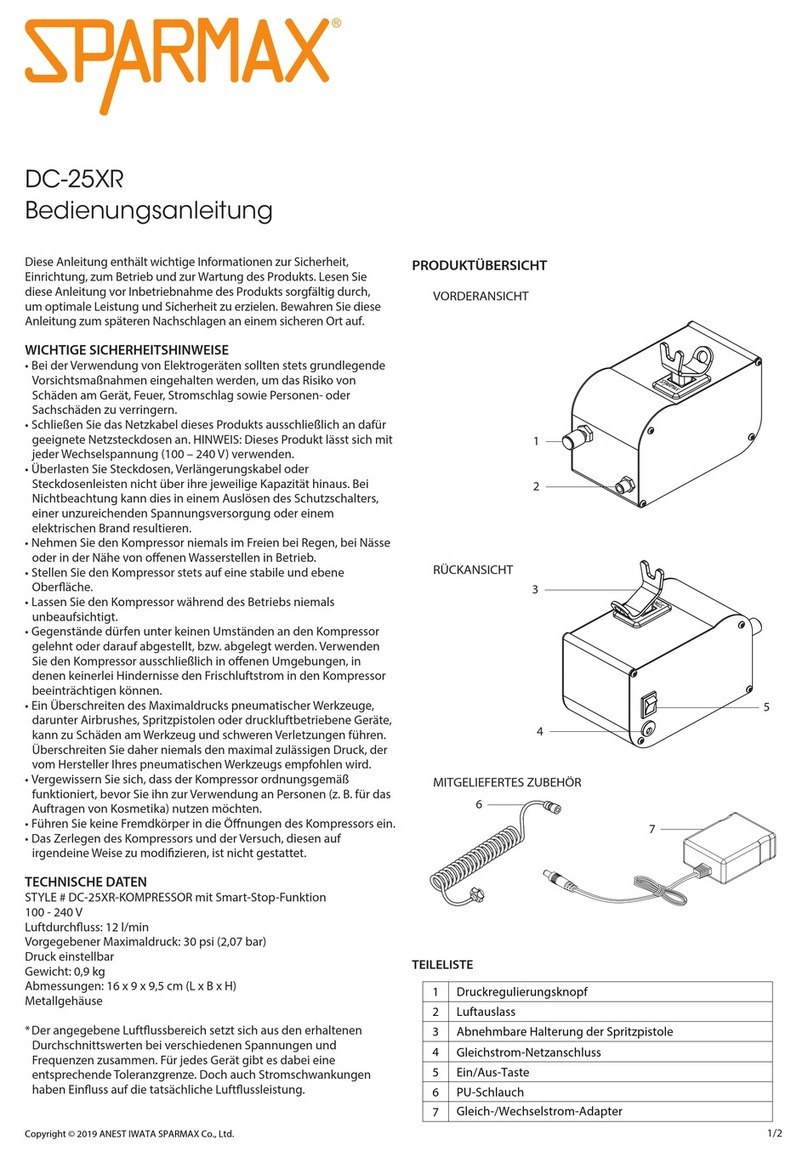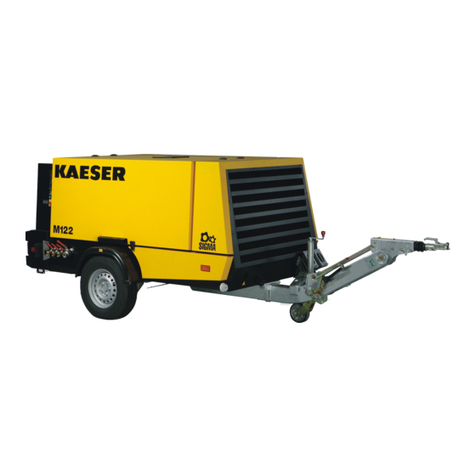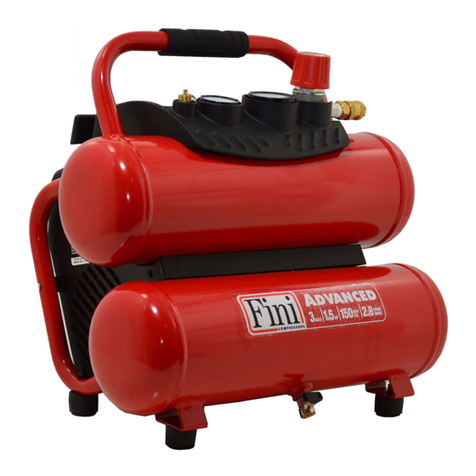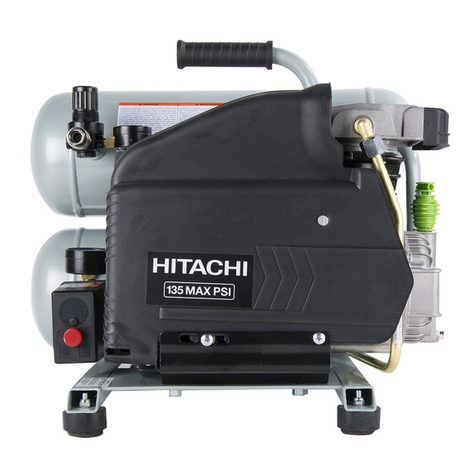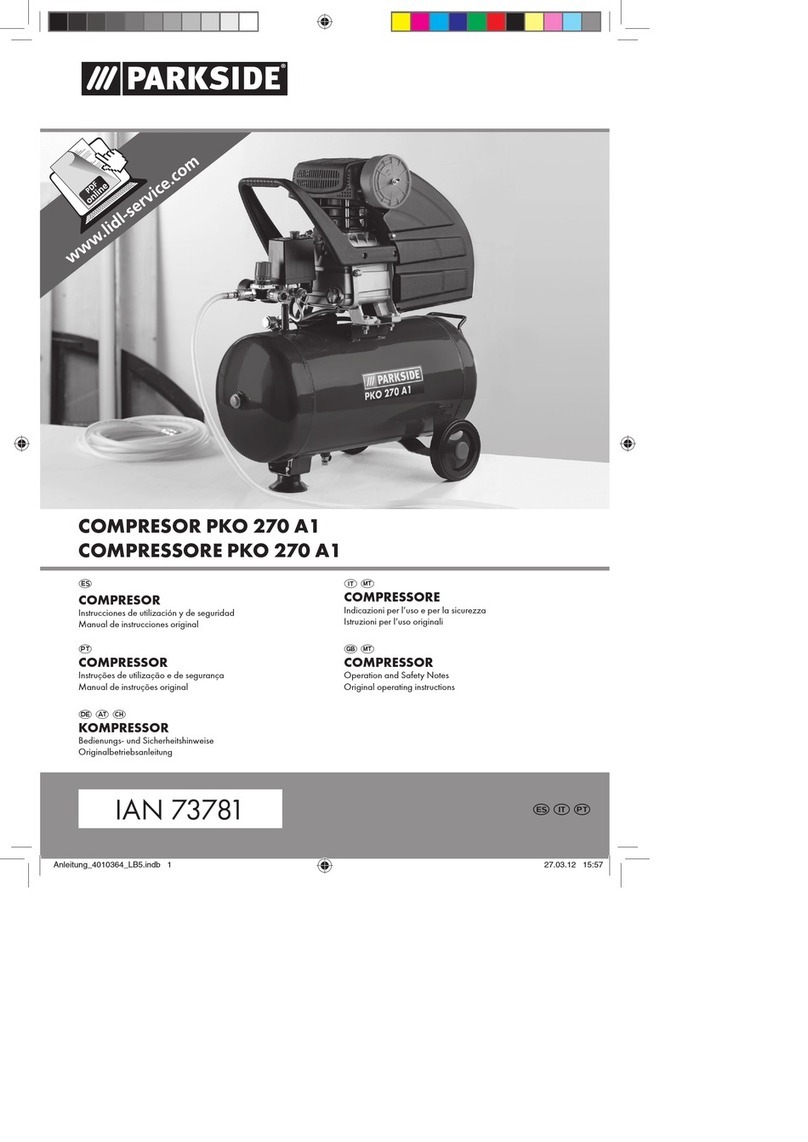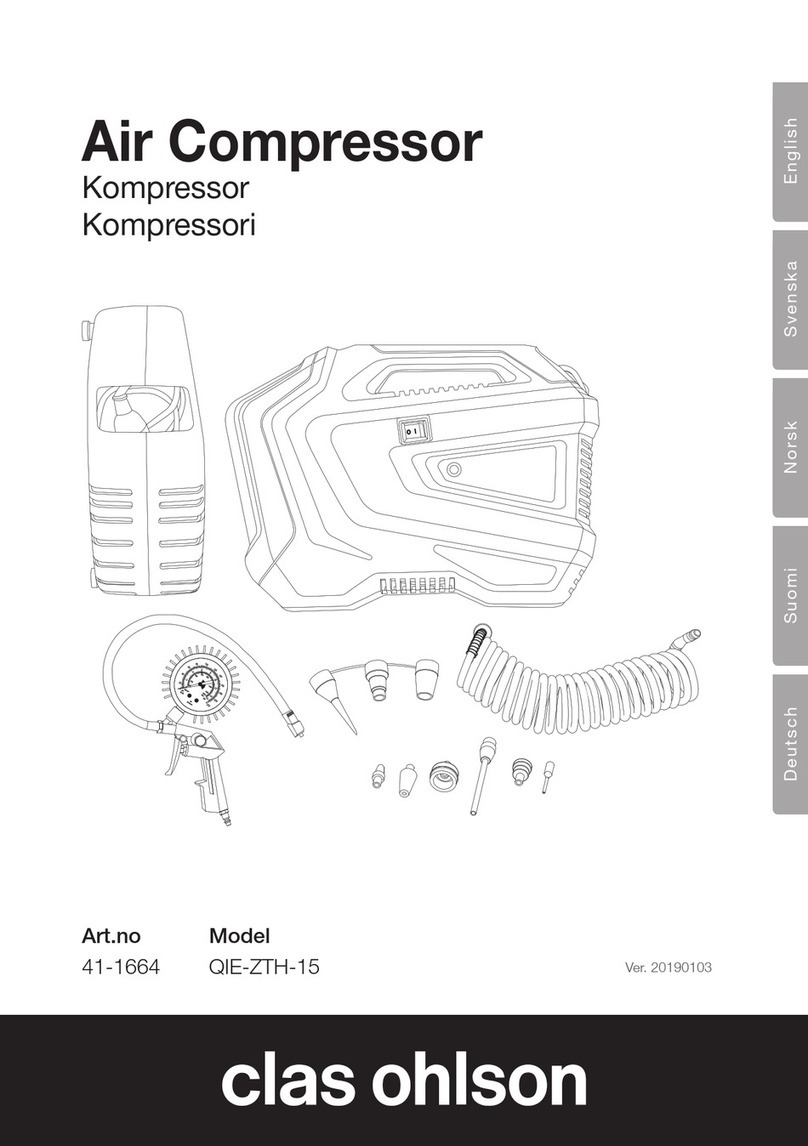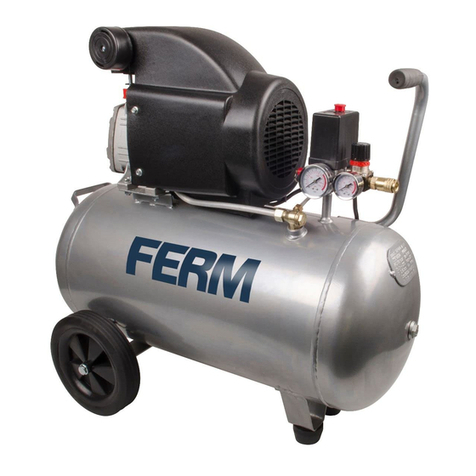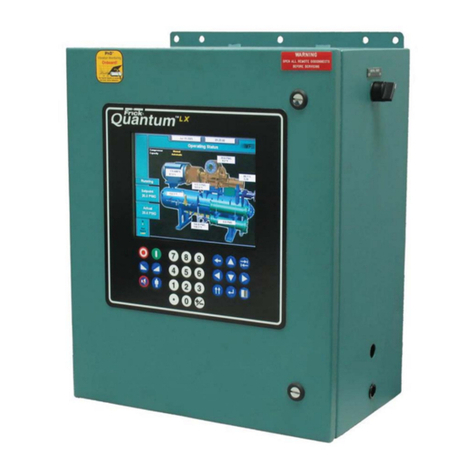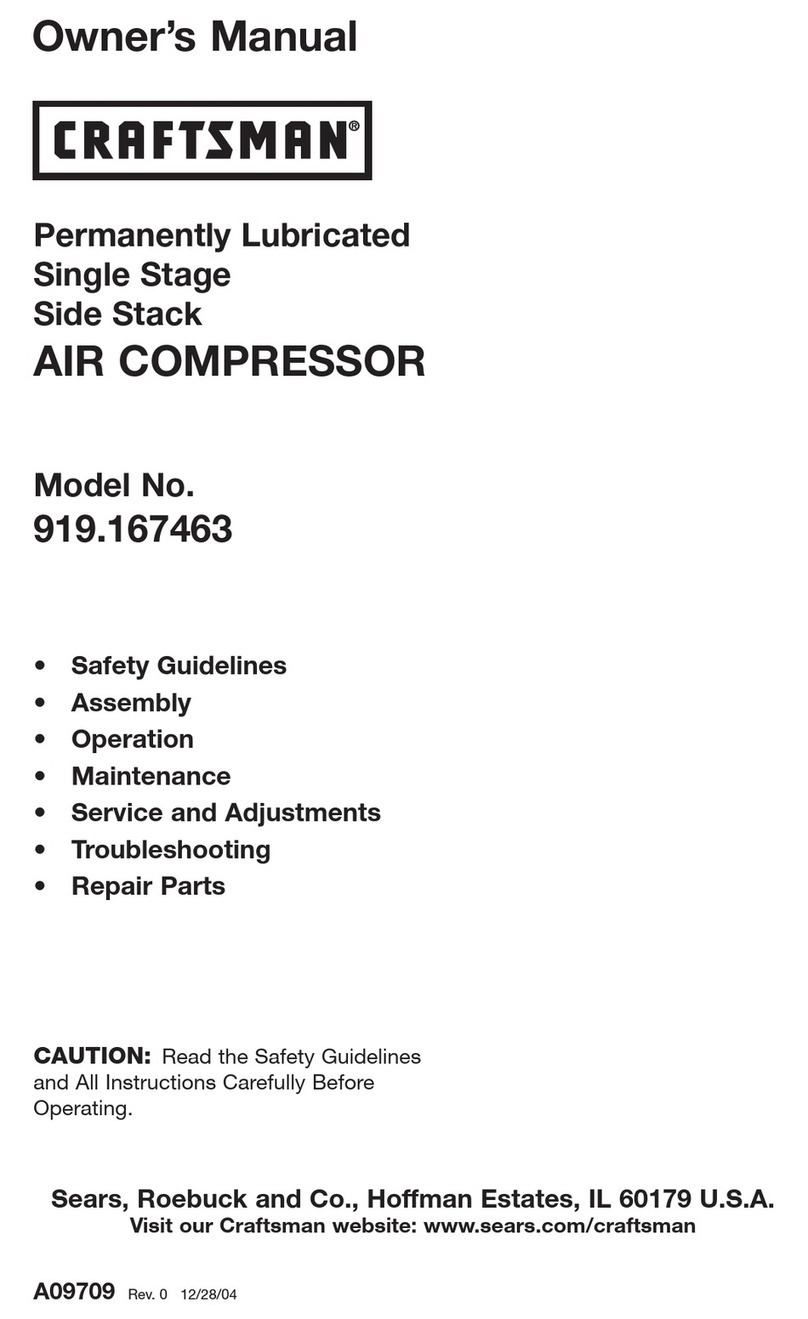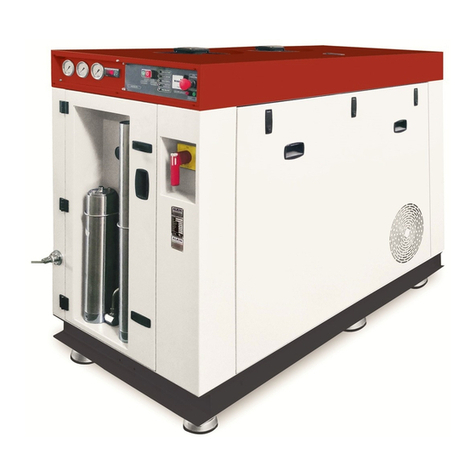
The appliance is not to be used by persons (including children) with reduced physical,
sensory or mental capabilities, or lack of experience and knowledge, unless they have
been given supervision or instruction.
Young children should be supervised to ensure that they do not play with the appliance.
WARNING! Before connecting a tool to a power source (mains switch power point receptacle, outlet,
etc.) be sure that the voltage supply is the same as that specied on the nameplate of the tool. A power
source with a voltage greater than that specied for the tool can result in serious injury to the user, as well
as damage to the tool. If in doubt, do not plug in the tool. Using a power source with a voltage less than
the nameplate rating is harmful to the motor.
• If oil leakage is found, do not start or run the compressor until the leak is xed and the spilled oil has been
wiped away.
• Always remove the plug from the mains socket before making any adjustments or performing
maintenance.
• To reduce the risk of re or explosion, never spray ammable liquids in a conned area. If sparks come
into contact with petrol vapours or solvents, they may ignite the vapours and cause a re or explosion.
• Always operate the compressor in a well ventilated area. Do not smoke while spraying. Do not spray
where sparks or ames are present. Keep the compressor as far away from the spray area as possible.
• The solvents trichloroethane and methylene chloride can chemically react with the aluminium used in
some paint spray guns and form an explosion. If these solvents are used, ensure that only stainless steel
spray equipment is connected. The compressor is not aected by the use of these solvents.
• Never directly inhale the compressed air produced by a compressor and do not use it for charging
breathing tanks.
• Do not use welding equipment in close proximity to the compressor. Do not weld anything to the air tank
of the compressor: this could dangerously weaken the tank and will void the warranty.
• Do not use the compressor outdoors when it is raining or on a wet surface; either situation could cause
an electric shock.
• Always maintain a safety distance of at least 3 meters between the compressor and the work area,
Ensure that the compressor is on a stable surface.
• Always use the handle to move the compressor.
• Never let the compressor come into contact with water or other liquids, as the appliance is live, this could
cause electrocution or short-circuits. Never use the appliance with bare feet, wet hands or wet feet.
•
Never pull on the power cable to disconnect the plug from the power outlet or to move the compressor.
• The compressed air produced by the compressor cannot not be used for pharmaceutical, food or medical
purposes or to ll the air bottles of scuba divers.
• Do not cover the air inlets on the compressor.
• Compressors and lines reach high temperatures during operation. Avoid contact! Risk of burns!
• Gases or vapours drawn in by the compressor have to be kept free of constituents that may cause re or
explosions inside the compressor.
• Do not attempt to adjust the pressure switch or the release valve located under the pressure switch cover.
• Drain the moisture from the tank after use. It will help prevent corrosion.
• Pull the ring on the safety valve daily to ensure that it is operating properly and to clear any possible
debris from the outlet.
• When you disconnect the hose coupling, hold the coupling element in your hand to prevent injury from
the whiplashing hose.
• Never point the blow-out gun at other persons and never use it to clean clothes that are still being worn.
• Be certain to read all the labels on the containers of paint or other materials to be sprayed. Closely follow
all safety instructions. Use a respirator mask if there is a chance that you might otherwise inhale the
spray material. Carefully check the eectiveness of any respirator mask you intend using.
• Always wear safety goggles or glasses when using the air compressor. Never point the nozzle of an
accessory towards any part of your body or towards another person.
• Keep the compressor at least 300mm from the nearest wall to ensure adequate ventilation for cooling
purposes.
• Protect the air hose and cordset from damage. Inspect for weak or worn spots regularly and replace if
necessary.
• Always switch o the compressor before switching o the power or removing the power plug.
• After using the compressor, switch o the on/o button, disconnect the power supply and release any
remaining pressure.
• Do not attempt to remove any part of the machine whilst it is under pressure.
• Always shut o the compressor after use and before servicing. Push the on/o knob down, wait for the
pressurised air to bleed from the tank from the safety valve and then remove the electrical plug from the
power supply.
• Check the maximum pressure rating of any tools or accessories that you intend using with the
compressor. The output pressure of the air from the compressor must be regulated so that it never
exceeds the rated pressure of the tool or accessory.
• To avoid the risk of burns and injury from moving parts, do not operate the compressor with the safety
shield removed. Allow hot parts to cool before handling or servicing.
• Wear goggles, wear earmus, wear a breathing mask. Use safety equipment including safety goggles
or shield, ear protection, breathing or respirator mask and protective clothing.
Never apply the outlet air of this compressor directly on to any part of a person’s body. Do not attempt to
block the air outlet with your nger or any part of your body.
The tool must be used only for its prescribed purpose. Any use other than those mentioned in this Manual
will be considered a case of misuse. The user and not the manufacturer shall be liable for any damage or
injury resulting from such cases of misuse.
The manufacturer shall not be liable for any changes made to the tool nor for any damage resulting from
such changes.
Even when the tool is used as prescribed it is not possible to eliminate all residual risk factors. The
following hazards may arise in connection with the tool’s construction and design:
• Damage to the lungs if an eective breathing mask is not worn.
• Damage to hearing if eective earmus are not worn.
• Damage to the eyes if eective safety goggles or shield are not worn.
WARNING! I
n the event that an air line is cut or broken, the air supply must be turned o at the
compressor. A broken air line which is not supported is extremely dangerous and can whip around very
quickly, both with the capability of striking people, and blowing foreign particles into the air.
Do not attempt to catch the air line but immediately keep bystanders well clear and turn o the air supply
to the hose, turn o the compressor at the On / O button, and then remove the hose from the compressor.
AIR COMPRESSOR SAFETY WARNINGS
GENERAL POWER TOOL SAFETY WARNINGS-PERSONAL SAFETY
ELECTRICAL SAFETY
WARNING! When using mains-powered tools, basic safety precautions, including
the following, should always be followed to reduce risk of re, electric shock, personal
injury and material damage.
Read the whole manual carefully and make sure you know how to switch the tool o in an emergency,
before operating the tool.
Save these instructions and other documents supplied with this tool for future reference.
The electric motor has been designed for 230V and 240V only. Always check that the power supply
corresponds to the voltage on the rating plate.
Note: The supply of 230V and 240V on Ozito tools are interchangeable for Australia and New Zealand.
If the supply cord is damaged, it must be replaced by an electrician or a power tool repairer in order to
avoid a hazard.
Using an Extension Lead
Always use an approved extension lead suitable for the power input of this tool. Before use, inspect the
extension lead for signs of damage, wear and ageing. Replace the extension lead if damaged or defective.
When using an extension lead on a reel, always unwind the lead completely. Use of an extension lead
not suitable for the power input of the tool or which is damaged or defective may result in a risk of re and
electric shock.
The power outlet for the compressor is recommended to be protected by a 30amp residual current device
WARNING! Read all safety warnings and all instructions. Failure to follow the
warnings and instructions may result in electric shock, re and/or serious injury.
Save all warnings and instructions for future reference. The term “power tool” in the warnings
refers to your mains-operated (corded) power tool or battery-operated (cordless) power tool.
1. Work area safety
a. Keep work area clean and well lit. Cluttered or dark areas invite accidents.
b. Do not operate power tools in explosive atmospheres, such as in the presence of ammable
liquids, gases or dust. Power tools create sparks which may ignite the dust or fumes.
c. Keep children and bystanders away while operating a power tool. Distractions can cause you to
lose control.
2. Electrical safety
a. Power tool plugs must match the outlet. Never modify the plug in any way. Do not use any
adapter plugs with earthed (grounded) power tools. Unmodied plugs and matching outlets will
reduce risk of electric shock.
b. Avoid body contact with earthed or grounded surfaces, such as pipes, radiators, ranges and
refrigerators. There is an increased risk of electric shock if your body is earthed or grounded.
c. Do not expose power tools to rain or wet conditions. Water entering a power tool will increase the
risk of electric shock.
d. Do not abuse the cord. Never use the cord for carrying, pulling or unplugging the power tool.
Keep cord away from heat, oil, sharp edges or moving parts. Damaged or entangled cords increase
the risk of electric shock.
e. When operating a power tool outdoors, use an extension cord suitable for outdoor use. Use of a
cord suitable for outdoor use reduces the risk of electric shock.
3. Personal safety
a. Stay alert, watch what you are doing and use common sense when operating a power tool. Do
not use a power tool while you are tired or under the inuence of drugs, alcohol or medication. A
moment of inattention while operating power tools may result in serious personal injury.
b.Use personal protective equipment. Always wear eye protection. Protective equipment such as dust
mask, non-skid safety shoes, hard hat, or hearing protection used for appropriate conditions will reduce
personal injuries.
c. Prevent unintentional starting. Ensure the switch is in the o-position before connecting to
power source and/or battery pack, picking up or carrying the tool. Carrying power tools with your
nger on the switch or energising power tools that have the switch on invites accidents.
d. Remove any adjusting key or wrench before turning the power tool on. A wrench or a key left
attached to a rotating part of the power tool may result in personal injury.
e. Do not overreach. Keep proper footing and balance at all times. This enables better control of the
power tool in unexpected situations.
f. Dress properly. Do not wear loose clothing or jewellery. Keep your hair, clothing and gloves away
from moving parts. Loose clothes, jewellery or long hair can be caught in moving parts.
g. If devices are provided for the connection of dust extraction and collection facilities, ensure
these are connected and properly used. Use of dust collection can reduce dust-related hazards.
h. Do not let familiarity gained from frequent use of tools allow you to become complacent and
ignore tool safety principles. A careless action can cause severe injury within a fraction of a second.
4. Power tool use and care
a. Do not force the power tool. Use the correct power tool for your application. The correct power
tool will do the job better and safer at the rate for which it was designed.
b. Do not use the power tool if the switch does not turn it on and o. Any power tool that cannot be
controlled with the switch is dangerous and must be repaired.
c. Disconnect the plug from the power source and/or the battery pack from the power tool before
making any adjustments, changing accessories, or storing power tools. Such preventive safety
measures reduce the risk of starting the power tool accidentally.
d. Store idle power tools out of the reach of children and do not allow persons unfamiliar with the
power tool or these instructions to operate the power tool. Power tools are dangerous in the hands
of untrained users.
e. Maintain power tools. Check for misalignment or binding of moving parts, breakage of parts and any
other condition that may aect the power tool’s operation. If damaged, have the power tool repaired
before use. Many accidents are caused by poorly maintained power tools.
f. Keep cutting tools sharp and clean. Properly maintained cutting tools with sharp cutting edges are
less likely to bind and are easier to control.
g. Use the power tool, accessories and tool bits etc. in accordance with these instructions, taking
into account the working conditions and the work to be performed. Use of the power tool for
operations dierent from those intended could result in a hazardous situation.
h. Keep handles and grasping surfaces dry, clean and free from oil and grease. Slippery handles and
grasping surfaces do not allow for safe handling and control of the tool in unexpected situations.
5. Service
a. Have your power tool serviced by a qualied repair person using only identical replacement
parts. This will ensure that the safety of the power tool is maintained.
